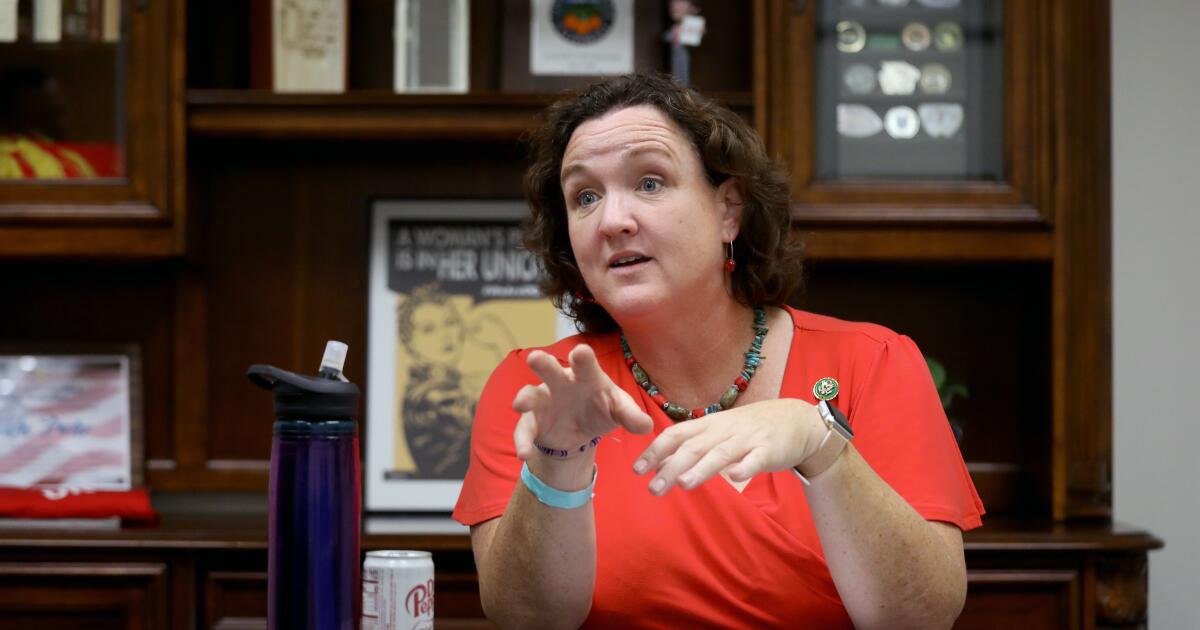State law bans certain ultra-processed foods from school meals

Just after 9:30 a.m. on a recent weekday, workers wearing hairnets in the Alhambra Unified School District’s central production kitchen were boxing the last of 350 handmade sushi rolls for the city’s three high schools.
Spicy tuna rolls, with the aroma of cooked fish mixed with Sriracha and mayonnaise, are a popular lunch among students.
“This is one of our signature dishes that we can never take away,” said Dwayne Dionne, culinary specialist at Alhambra Unified.
Alhambra Unified has been selling sushi for about 25 years. The region once switched from white rice to brown rice, a healthier whole grain. However, the meals will come under strict scrutiny under new state law, the Real Food, Healthy Kids Act.
Amanda Tejada loads a plate of chicken salad for storage in the refrigerator at Alhambra Unified Central Production Kitchen.
(Karin Steele/Los Angeles Times)
The law signed by Gov. Gavin Newsom on Wednesday provides the nation’s first statutory definition of ultra-processed foods and will ban some “concerning” foods from California schools starting in 2035.
Under the legislation, which is expected to bring major changes to school cafeteria meals, the state’s Department of Public Health will have until 2028 to identify ultra-processed foods of “concern” and “restricted school foods” (another prohibited category). After a year, schools must begin phasing them out.
“This is a great opportunity to help a lot of people in a very direct way,” said Rep. Jesse Gabriel (D-Encino), the legislation’s author. “I’m still learning about it all…I [was] Going to the grocery store trying to do the right thing for my kids not knowing we could be feeding them something that could be harmful. “
For years, scientific research has shown that ultra-processed foods cause serious health problems in children, increasing the risk of obesity and asthma. Ashley Gearhardt, a professor of psychology at the University of Michigan, said children are particularly vulnerable to the effects of “high-risk” ultra-processed foods that offer “very unnatural beneficial ingredients like refined carbohydrates and added fats, and…these colorings, preservatives and flavor enhancers are amplifying their effects.”

Dwayne Dionne is Alhambra Unified’s culinary specialist and works in the district’s central production kitchen.
(Karin Steele/Los Angeles Times)
These ingredients may trigger “compulsive and addictive behaviors” in children [behavior] “You see this all the time with these types of products,” said Gearhart, an expert on food addiction who testified in support of the bill.
The legislation would not ban all ultra-processed foods from being served in schools – far from it.
Consider Alhambra Unified’s Sriracha Spicy Tuna Roll. Sriracha may be considered an ultra-processed food (due in part to the presence of xanthan gum, a thickening agent), but it is not expected to be classified as such under the new law’s definition of the category. As a result, experts say, sushi is unlikely to be considered an ultra-processed food of “concern” and won’t appear on the “restricted” list.
That’s good news for Patti Zaragoza, a food service worker at Alhambra Unified Central Kitchen. After boxing up the last of her 350 sushi rolls, she said she would never get tired of them.
“Oh no, I love it!” she said.
Take the legal road
For Gabriel, who was first elected in 2018, the Real Food, Healthy Kids Act marks the third food-related law he has spearheaded.
In 2023, Gabriel drafted the California Food Safety Act, which would ban many food additives commonly found in sodas, candy and cereal, including No. 3 red dye. A year later, the congressman authored the California School Food Safety Act, which received widespread attention for banning schools from selling Flamin’ Hot Cheetos and other products containing certain synthetic food colorings.
Gabriel says his long involvement in food safety was an unexpected turn — but a personal one. He has three children in elementary school. “A lot of the way I see the world is through my dad’s eyes,” he said.
A turning point: Gabriel learned that the adverse effects of certain synthetic food colorings may be amplified in children with attention-deficit/hyperactivity disorder.
ADHD “is something I struggled with as a kid and one of my sons is struggling with,” he said.
Since Gabriel began drafting food-related legislation, the rise of the controversial “Make America Healthy Again” movement has brought attention to issues related to dyes and other additives and their possible links to various health problems. But he said the new law stemmed from “sound science,” adding, “We were doing a lot of this before anyone had ever heard of MAHA.”
“California has never waited for Washington or anyone else to take the lead on children’s health issues,” Newsom said in a statement.
“We have been leading the way for many years in eliminating harmful additives and improving nutrition in schools,” he said. “This first-in-the-nation law builds on that work to ensure every California student has access to healthy, delicious meals that help them thrive.”

Carol Chan hands out beef and bean chili at the Alhambra Unified Central Production Kitchen.
(Karin Steele/Los Angeles Times)
Gabriel’s bill has strong bipartisan support. But it faced opposition from groups including the California Farm Bureau. Christopher Reardon, the bureau’s vice president for policy advocacy, said in a statement that the bureau “supports efforts to improve public health” but has questions about how to implement the law.
He said the Farm Bureau “will continue to work with its agricultural alliances to advocate for science-based food classification standards and ensure legislation supports farmers as they adapt to changes.”
within the ban
So what would be banned?
it’s complicated.
First, to be considered ultra-processed, a food must contain one of eight categories of unnatural substances, including emulsifiers, stabilizers, flavor enhancers and flavorings. Then, it must contain high amounts of saturated fat, sodium or added sugar, or contain some kind of non-nutritive sweetener.
There are a few exceptions. For example, a food that is considered ultra-processed simply because it contains salt or certain natural flavorings cannot be classified as ultra-processed. Other items cannot be considered ultra-processed, including unprocessed agricultural products.
Gabriel said he is working with the food and beverage industry to exempt certain items that make sense, such as minimally processed prepared foods, which includes canned fruits and vegetables. He said we had talks with representatives from the dairy industry, the protein industry and some industries that don’t even serve food in schools, such as alcohol manufacturers.
“The question for a lot of them is, ‘When you define ultra-processed foods, how do you do that? How does that impact our products?'” he said.
It is unclear which foods will be considered ultra-processed foods of “concern” or which foods will be classified as “restricted.” The state’s Department of Public Health will develop these food lists by 2028 so schools can be prepared when the ban takes effect.
The department must weigh multiple factors, including whether the products contain a warning label about “adverse health consequences” in another jurisdiction and whether they contain substances “based on reputable peer-reviewed scientific evidence” that are associated with “health hazards or adverse health consequences” such as cancer and cardiovascular disease.
“This investigation should be conducted by California scientists, not legislators,” said Scott Farber, senior vice president of government affairs for the nonprofit Environmental Working Group, who testified in support of the legislation.

Andrew Vasquez prepares black bean and corn relish in Alhambra Unified’s central production kitchen.
(Karin Steele/Los Angeles Times)
The law would put the blame on vendors, banning them from selling prohibited items to California school districts starting in 2032. But it’s unclear how the district will respond.
Los Angeles Unified, the state’s largest provider of school meals, declined an interview with its food services director.
William Fong, director of food and nutrition services for Alhambra Unified, noted that his district already meets USDA school food standards. Even if changes are needed, complying with the new standards won’t be too difficult, he said.
“We always have ways to substitute items in…recipes,” Fong said. “And we still have time.”
Gabriel believes vendors who supply food to school districts will comply with the law because California is a lucrative market for them. This might be as simple as swapping out an ingredient or two on your pepperoni pizza or corn dogs.
He also noted that California schools will serve about 1 billion meals this year.



